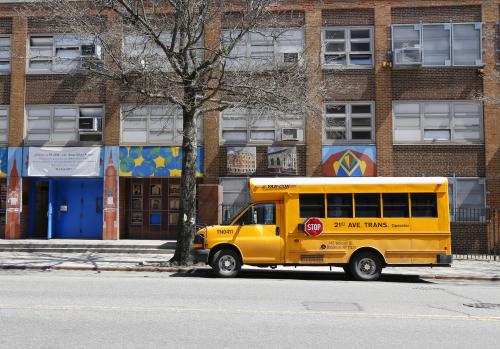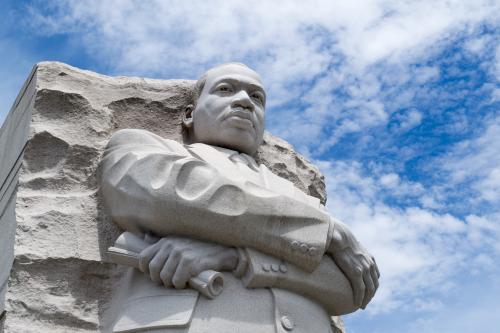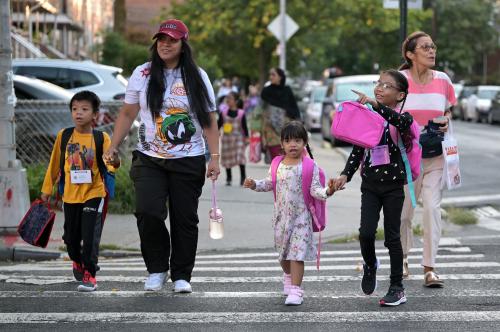This story was produced by The Hechinger Report, a nonprofit, independent news organization focused on inequality and innovation in education.
“In education, America does everything but equity.” With these words, Failing Brown v. Board, a new report from the civil rights group Journey for Justice Alliance, makes plain how the machine of educational reform, with all its innovations and disruptive technologies, is missing an essential cog: the resources to deliver a quality neighborhood school.
Most states cut education spending in the 2008 recession. Yet, despite the economy having recovered, there is less funding today for education than even those lean years, according to the Center on Budget and Policy Priorities. Researchers from this non-profit found that in 2015, “29 states were still providing less total school funding per student than they were in 2008.”
No wonder the quality of our schools is suffering, and parents are grasping at straws. But the seductive promise of educational programs that don’t grapple with the roots of inequality will eventually ring hollow.
A few days ago, the director of Journey for Justice Alliance, Jitu Brown—alongside other civil rights groups including the NAACP, the Advancement Project, American Federation of Teachers and the National Education Association—held a press conference on the steps of the Supreme Court in Washington, D.C. The occasion was the release of the report, to do what many reformers openly refuse to—confront a system of segregated schools.
Segregated housing and schools, gerrymandered districts and voter suppression picked up were Jim Crow left off. Housing ghettos are born of racist housing policies that rob the black community of opportunities to amass wealth. According to Prosperity Now, a national nonprofit to expand economic opportunity for low-income families, and the Institute for Policy Studies, a progressive think tank, white households have seven times the amount of wealth as African Americans, and six times as much as Latinos.
Wealthier neighborhoods hoard wealth and maintain a racially separate school system through a financial structure based on property taxes. Local school districts rely heavily on the revenue that comes from local property taxes, creating funding disparities between rich and poor districts. These primary sources of inequality continue to limit opportunities, suppressing the social mobility of subsequent generations. Yet many education reformers avoid, accept—or even embrace!—segregation, knowing that federal policy got us into this mess and only federal policy can get us out.
In December 2017, in response to an Associated Press report that showed charters were more segregated than traditional schools, the National Alliance for Public Charters essentially said, research be damned; that it was not their concern. “In the end, parents’ and students’ opinions are the only ones that matter,” read the official statement.
That was the moment many charters school leaders relinquished any claim of being reformers. It was white parents choosing segregation that helped get us to this state. Education reform must be in the business of educating our youth in non-discriminatory environments. Making people upwardly mobile requires providing great schools and dismantling systems that keep students from receiving what they need to be successful. I’ve argued in earlier columns that because charter schools aren’t bound to geographic zones, they should be strategically placed to integrate areas where racial and economic segregation is reinforced by district lines.
Brown and the other activists are right to demand the right to have a decent neighborhood school. If the leaders of the charter school lobby were truly sincere about equity in education, they should have joined Brown on those Supreme Court steps. Working on federal policy and law that gives people a pathway out of poverty requires more than lip service to “choice.”
“Every parent deserves choices about where they will send their child to school,” proclaimed Texas Governor Greg according to a Texas Observer report on a 2017 rally for school choice. “All these parents know this isn’t a Republican issue, it’s not a Democrat issue. This is a civil rights issue.” Choice has been the rallying cry for defenders of charter schools, voucher systems and other contrivances that purport to free students from oppressive public school structures. Many claim this is the civil rights issue of our time.
Many education reformers avoid, accept—or even embrace!—segregation, knowing that federal policy got us into this mess and only federal policy can get us out.
Some civil rights groups, including those who attended yesterday’s rally, feel differently. When the NAACP, one of our country’s foremost civil right organizations, voted on a resolution to place a moratorium on charter schools, the backlash from charter advocates was swift and often times mean-spirited. One hundred and sixty black leaders, part of the charter lobby, signed a letter encouraging the NAACP to back off, saying: “For many urban Black families, charter schools are making it possible to do what affluent families have long been able to do: rescue their children from failing schools.” This is a lie. Giving low-income, black people charter schools without making them wealthy will never give them the same educational options as the affluent class. As a former charter leader, I’ve seen us make wealthy people the standard, then pitch false promises to families on how to reach it. But it never works.
In addition, more schooling isn’t going to close the racial wealth gap. Let’s stop promoting the idea that affluent people became wealthy from their dedication to education. Slavery, job discrimination and redlining, which took away the ability of black people to establish equity in a home, had much more to do with creating affluence for white people and giving them the ability to choose. Charter schools that accept segregation as a default don’t help rescue black children, contrary to what the letter to the NAACP argued. Students aren’t trapped in failing schools as much as they are trapped in poverty fueled by segregation.
Giving low-income, black people charter schools without making them wealthy will never give them the same educational options as the affluent class.
As the Failing Brown v. Board report states, “The refusal to offer Black and Brown and poor children the same resources and educational opportunities that are offered to white and wealthy children continues to be a national crisis that has yet to be acknowledged or addressed by those in positions of power.”
Elsewhere, the report references the Little Rock 9, who in 1957 integrated Central High School in Little Rock, Arkansas. It was a test case to see if a district would enforce the landmark 1954 Supreme Court ruling that desegregated education, Brown v Board. “These students endured discrimination, physical and emotional violence for their entire time at Central High School to make America honor a Supreme Court mandate,” Jitu Brown wrote. Reformers keep trying to work around segregation, discrimination and structural racism. Yet as those nine teenagers showed us, change requires us to break down these barriers. And in order to do that, we need to fight segregated schools.







Commentary
We need to fight segregated schools to reform the education system
May 17, 2018